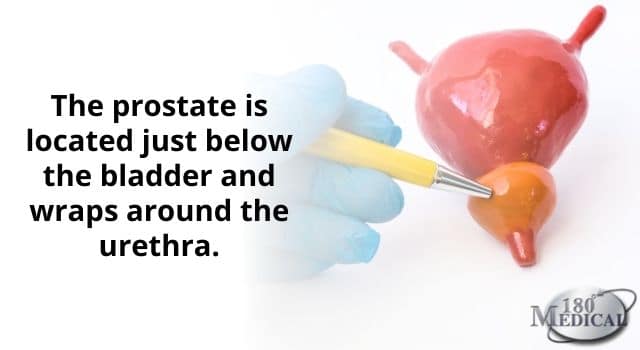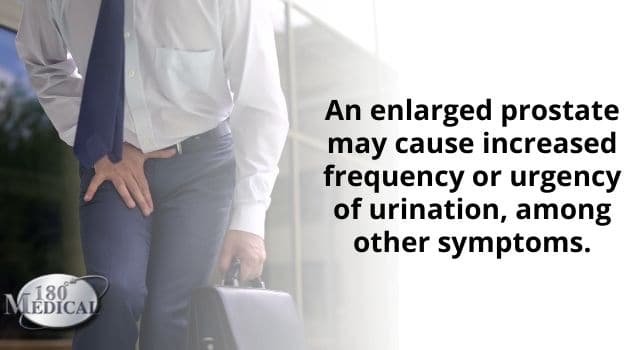
A lot of people in the 180 Medical community use catheters due to living with BPH (benign prostatic hyperplasia), which is also known as an enlarged prostate. However, they don’t always realize just how many others are also living with this condition and using catheters too.
As a person with a prostate gets older, they’re increasingly at risk of their prostate enlarging. In fact, according to Cleveland Clinic, by age 60, 50% of males may be living with BPH. It doesn’t stop there. By age 85, 90% may see symptoms of an enlarged prostate.
Today, we’d love for you to meet Donald, who has been living with BPH since 2017.
What is BPH?
First, you may be wondering: “What is BPH?” BPH, or benign prostatic hyperplasia, is essentially when the prostate enlarges over time.
So what is a prostate? The prostate is a male reproductive gland that’s typically about the size of a walnut, and it is located just below the bladder. It also wraps around the urethra, which is the tube through which urine flows from the bladder.

Because of the position of the prostate, when it enlarges, this can sometimes interfere with normal urinary function. As it gets bigger, the enlarged prostate may pinch the urethra or crowd the bladder. BPH may create blockages, which can lead to urinary retention and the need for intermittent catheterization.
What Are the Symptoms of BPH?
So how do you know if your prostate is enlarged? 180 Medical Community member Donald certainly never expected his diagnosis of BPH when he went to see his doctor. At first, he was primarily experiencing what he thought was excess gas and abdominal pain.
So what are some other common symptoms of living with BPH and bladder retention? If your enlarged prostate is creating pressure on the bladder or urethra, you may experience symptoms such as:
- A feeling of fullness or pain in the lower abdominal area
- Increased frequency or urgency of urination
- Still feeling as if you need to urinate after voiding the bladder
- Waking up frequently at night to urinate (nocturia)
- Dribbling after urination (also known as Post-Void Micturition)
- Straining or pushing to urinate
- Weak stream or having to stop and start while urinating

How Is BPH Diagnosed?
Donald says that when he visited his doctor about his unusual symptoms, he was sent to the hospital to complete an abdominal scan. In the middle of this procedure, Donald was told to go to the restroom and urinate and then return to complete the scan. This test would show if his bladder was retaining fluid after normal urination.
Indeed, Donald’s scan indicated a diagnosis of urinary retention. “I still had 600 ccs in my bladder.” In addition, he had some benign cysts on his gallbladder.
However, that wasn’t the end of Donald’s journey. His urologist sent Donald home with a single rubber catheter to wash and reuse. This would help Donald with his symptoms of bladder retention and help him void his bladder entirely.
Later, when his insurance changed, he transferred to another urologist. “The doctor and nurses were fantastic there,” says Donald. “They gave me a battery of tests, including urodynamics tests and a cystoscopy,” which is an exploratory scope that allows the doctor to examine the interior of the urethra and bladder.
That’s when Donald finally learned he had BPH, an enlarged prostate, which was the cause of his urinary bladder retention.
Other tests that can diagnose urinary retention and/or BPH can include a urine flow study, a digital rectal exam, ultrasounds, or MRIs.
Learning How to Cath After a BPH Diagnosis
Donald’s doctor gave him a regular prescription for intermittent catheters, and Donald discovered 180 Medical.
“Learning how to use catheters was scary at first, but I managed just fine,” he says, looking back. In addition to an instructional sheet given to him by his urologist, Donald found 180 Medical’s catheterization resources very helpful too.
His advice for other men new to using catheters after being diagnosed with BPH or bladder retention is to check out 180 Medical’s online instructions and videos. “They are of more help than I had at the beginning of my journey,” he says. “They’re very good.”
He also says to remember that “The first time is the worst.” As you practice, he says, it gets easier and easier over time.
Finding the Right Catheter
Through 180 Medical, Donald got to sample a few different types and brands of intermittent catheters. This helped him experiment and discover what worked and felt best for his individual needs as a man living with BPH and urinary bladder retention.
After trying out some options, he discovered he preferred red rubber latex catheters. The standard vinyl and silicone straight catheters he tried out felt too rigid for his preferences.
Today, he receives the Rusch Robinson-Nelaton Red Rubber Catheter. “For me, I like the flexibility and ease of use,” he says. “I’m not allergic to latex, and they feel more environmentally-friendly [than plastic].”
Want to learn more about the wide range of catheter options available to you at 180 Medical?
Contact us to try out some free catheter samples. We can verify your insurance plan and help you understand your catheter coverage while working with your doctor’s office to retrieve any documentation your plan may require, including a prescription and doctor’s progress notes.
Traveling with Catheters
As a frequent traveler, Donald says he has no problems with taking his catheters wherever he goes. “I have a pouch in my briefcase or carry-on that holds a bunch when I travel.”
Also, another upside of his red rubber latex catheters is that he can roll them up inside the package to place them in a pocket or briefcase discreetly without damaging the catheters.
“I’ve catheterized on domestic and international flights, in airports, and on trains with no problem!”

More About Donald
Outside of his experiences with BPH and bladder retention, Donald’s life has been filled with music, teaching, and traveling. He has a Ph.D. in vocal music education. “For 38 years, I taught voice and choral music in Nebraska and Texas before I retired in August 2018.”

Today, he’s grateful for the love and support of his wide network of family and friends. Tragically, he lost his husband in a car-bicycle accident several years ago. However, he still has two brothers, 3 nieces, a nephew, and even some great-nieces and nephews. “I also have a host of friends and former students who are teaching now in the USA and Japan that are my ‘children.'”
We’re so grateful for Donald for sharing his story. So many men deal with living with BPH and bladder retention solitarily without knowing if others understand or are also going through the same thing.
If you’re dealing with difficulty urinating, it could be due to an enlarged prostate or another serious issue. Be sure to visit your doctor if you’re experiencing any unusual symptoms.
Additionally, if you need a reliable catheter supplier, a listening ear is just a phone call away at 180 Medical. Contact us today!
Disclaimer: The information in this article is not medical advice. It is not intended as a substitute for consultations with qualified healthcare professionals. For questions requiring medical advice, please talk to your doctor or another qualified medical professional.
